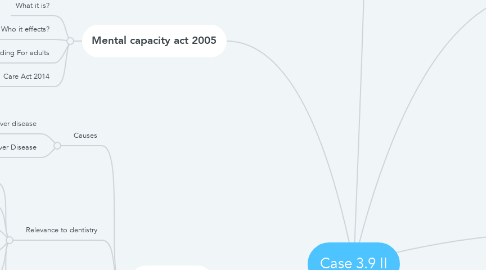
1. Liver disease
1.1. Causes
1.1.1. Fatty Liver disease
1.1.1.1. Alcohol abuse
1.1.2. Non Fatty Liver Disease
1.1.2.1. Hepatitis
1.2. Relevance to dentistry
1.2.1. Drug metabolism
1.2.2. Orofacial signs
1.2.3. Jaundice
1.2.4. Coagulation
1.2.5. Management in dental practice
1.2.6. Pt with Hep B/C
1.3. Management
1.4. Risk Factors
1.5. Systemic signs and symptoms (Neutropenia)
1.6. Healthy Liver
1.6.1. Fuctions
1.6.2. Phisiology
1.6.3. Anatomy
2. Mental capacity act 2005
2.1. What it is?
2.2. Who it effects?
2.2.1. Dementia
2.3. Safeguarding For adults
2.3.1. Policy
2.4. Care Act 2014
3. Bone
3.1. Health
3.1.1. Function
3.1.2. Metabolism
3.1.3. Structure
3.2. Disease
3.2.1. CommonMetabolic
3.2.1.1. Osteoperosis
3.2.2. Common Infectious
3.2.2.1. Osteomyelitis
3.2.3. Common Inherited
3.2.3.1. Osteogenesis imperfecta
3.2.3.2. Cleidocranial dysplasia
3.2.4. Dental related
3.2.4.1. Osteoradionecrosis
3.2.4.2. Alveolar osteitis
3.2.5. Management
3.2.6. Medication
3.2.6.1. MRONJ
3.2.6.1.1. Bisphosphonates: How they effect bone structure?
4. White blood cell disorders
4.1. Haematology
4.1.1. Normal
4.1.1.1. Function of each WB cell
4.1.2. Abnormal
4.2. Common white blood cell disorders
4.2.1. Neutropenia
4.2.2. Leukaemia
4.2.3. Lymphoma
4.2.4. AIDS
4.3. Oral presentations
4.4. Signs and symptoms
5. Facial Pain
5.1. Differential diagnosis
5.2. Muscular causes
5.3. Bone associated
5.4. Dental related pain
5.5. Migraine
5.6. Herpes Zoster of the trigeminal nerve (shingles)
5.7. TMJ Fibromyalgia
5.8. Temporal arteritis
5.9. Atypical facial pain
5.10. Trigeminal neuralgia
5.11. Neuralgia inducing osteonecrosis
5.12. Glossopharyngeal neuralgia
5.12.1. Management
6. Trauma
6.1. Trauma to the Adult dentition
6.1.1. Types of trauma
6.1.2. Avulsion, Luxation, Subluxation, Intrusion, extrusion, Concussion
6.1.2.1. Management
6.1.2.1.1. Splinting
6.1.3. Fractures: Enamel, Dentine and pulp, root
6.1.4. Sequalae
6.2. Trauma to the primary dentition
6.2.1. Types of trauma
6.2.1.1. Management
6.2.2. Sequalae
7. Psychiatric disorders
7.1. Types of psychiatric disorders
7.1.1. Schizophrenia
7.1.2. Bipolar
7.1.3. Anxiety
7.1.4. Depression
7.1.5. Behavioural
7.2. Magnagement
7.2.1. CBT
7.2.2. Electro theraapy
7.2.3. Antidepressants
7.2.4. Antipsychotics
7.3. Relevance to dentistry
7.3.1. Medication related
7.3.2. Drug interactions
7.3.3. General management
